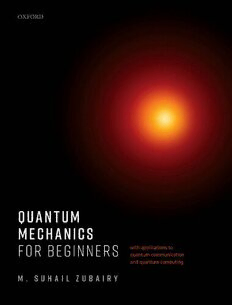
Quantum Mechanics for Beginners - with applications to quantum communication and quantum computing PDF
Preview Quantum Mechanics for Beginners - with applications to quantum communication and quantum computing
OUPCORRECTEDPROOF – FINAL,10/3/2020,SPi Quantum Mechanics for Beginners OUPCORRECTEDPROOF – FINAL,10/3/2020,SPi OUPCORRECTEDPROOF – FINAL,10/3/2020,SPi Quantum Mechanics for Beginners with applications to quantum communication and quantum computing M. Suhail Zubairy TexasA&MUniversity 1 OUPCORRECTEDPROOF – FINAL,10/3/2020,SPi 3 GreatClarendonStreet,Oxford,OX26DP, UnitedKingdom OxfordUniversityPressisadepartmentoftheUniversityofOxford. ItfurtherstheUniversity’sobjectiveofexcellenceinresearch,scholarship, andeducationbypublishingworldwide.Oxfordisaregisteredtrademarkof OxfordUniversityPressintheUKandincertainothercountries ©M.SuhailZubairy2020 Themoralrightsoftheauthorhavebeenasserted FirstEditionpublishedin2020 Impression:1 Allrightsreserved.Nopartofthispublicationmaybereproduced,storedin aretrievalsystem,ortransmitted,inanyformorbyanymeans,withoutthe priorpermissioninwritingofOxfordUniversityPress,orasexpresslypermitted bylaw,bylicenceorundertermsagreedwiththeappropriatereprographics rightsorganization.Enquiriesconcerningreproductionoutsidethescopeofthe aboveshouldbesenttotheRightsDepartment,OxfordUniversityPress,atthe addressabove Youmustnotcirculatethisworkinanyotherform andyoumustimposethissameconditiononanyacquirer PublishedintheUnitedStatesofAmericabyOxfordUniversityPress 198MadisonAvenue,NewYork,NY10016,UnitedStatesofAmerica BritishLibraryCataloguinginPublicationData Dataavailable LibraryofCongressControlNumber:2020934341 ISBN978–0–19–885422–7(hbk.) ISBN978–0–19–885423–4(pbk.) DOI:10.1093/oso/9780198854227.001.0001 Printedandboundby CPIGroup(UK)Ltd,Croydon,CR04YY OUPCORRECTEDPROOF – FINAL,10/3/2020,SPi Dedicatedtomybeloved Zoya,Aliya,Qasim,Sameer,andKhalid OUPCORRECTEDPROOF – FINAL,10/3/2020,SPi OUPCORRECTEDPROOF – FINAL,10/3/2020,SPi Preface The laws of quantum mechanics were formulated about a hundred years ago, replacing the classical laws of Newton and Maxwell. Since then, quantum mechanics has been applied remarkably successfully to understand a very wide range of observations and systems. The success of the laws of quantum mechanics in predicting and explaining essentially all the knownphysicalphenomenaisastounding.However,inspiteofthegreatsuccess,itremains a mysterious theory and the concepts of wave–particle duality, complementarity, the prob- abilistic nature of measurement, quantum interference, and quantum entanglement are still hotly discussed. However, it is not just the remarkable success in explaining all the known phenomenathatmakesquantummechanicsafascinatingsubject.Itistrulyamazingthat,even today,amereknowledgeofthebasicpostulatescanleadtostartlingnewideasanddevices.For example,justtheknowledgeoftheprincipleofcomplementaritycanleadtoperfectlysecure communicationsystems,ortheunderstandingofabeamsplitterforasinglephotoncanleadto ahighlycounterintuitivecommunicationprotocolwithnoparticlepresentinthetransmission channel, or the resource of quantum entanglement can lead to novel quantum computing algorithms. Therefore it becomes possible to convey not only the foundations of quantum mechanics but also some mind-boggling applications, such as in quantum communication andquantumcomputing,withjustelementaryknowledgeofbasicphysicsandmathematics. With this background it is interesting to ask whether it is possible to convey the basic concepts of quantum mechanics and its amazing applications to someone with a limited knowledge of physics and mathematics. In the fall of 2018, I offered a course on Quantum MechanicstoincomingfreshmanstudentsatTexasA&MUniversity.Thesestudents,justoutof highschool,tookthiscoursebeforetheytooktheusualMechanicsandElectricity/Magnetism courses.Thisbookgrewoutofthelecturenotesofthiscourse.Themainobjectiveofthisbookis topresentanintroductiontoquantummechanicsinanalmostself-containedwayforsomeone withahighschoolphysicsandmathematicsbackground. The book challenges the common perception that quantum mechanics is a highly math- ematicalandabstract subject thatisinaccessibletoanyonewithoutanadvanced knowledge of mathematics. This book, except the last chapter on the Schrödinger equation, is entirely algebra-based.Aneffortismadetoderivesomeamazingresultsfromverysimpleideasandele- mentarymathematicaltools.Ideallyeverychapteroffersresultsthatarehighlycounterintuitive andinteresting.Thisbookcanbeusedasatextforacourseonquantummechanicsorquantum informaticsattheundergraduatelevel.Howeveritcanalsobeausefulandaccessiblebookfor thosewhoarenotfamiliarwithbutwanttolearnsomeofthefascinatingrecentandongoing developmentsinareasrelatedtothefoundationofquantummechanicsanditsapplicationsto areassuchasquantumcommunicationandquantumcomputing. Thebookisdividedintofourparts.Afteranintroductorychapter,somebasicmathematical toolssuchas complexnumbers,vectoranalysis,andintroductiontoprobability aswell asa classicaldescriptionofparticles and wavesareintroduced in thenextthreechapters. Inthe OUPCORRECTEDPROOF – FINAL,10/3/2020,SPi viii PREFACE nexteightchapters,basicconceptsofquantummechanicsarediscussed,suchaswave–particle duality, complementarity, the Heisenberg uncertainty relation, quantum interference and entanglement,no-cloningtheorem,aswellasissuesatthefoundationsofquantummechanics suchasthedelayed-choicequantumeraser,theSchrödinger’scatandEPRparadoxes,andBell theorem. In the following chapters, these fundamentals of quantum mechanics are applied to applications in areas such as secure quantum communication, quantum teleportation, counterfactualcommunication,andquantumcomputation.Inthelastpart,theSchrödinger equation is introduced with its relation to Newtonian dynamics and its applications for a particleinsideaboxandthehydrogenatom. Each chapter is followed by a short bibliography, guiding an interested reader to some relevantbooksandpapers.Insomeinstances,theoriginalpapersareincludedinthelist.No attempthas,however,beenmadetogiveanexhaustivelistofreferences.Anumberofproblems arealsogivenattheendofeachchapterforthestudentsincasethebookisfollowedasatext foracourse. I owe my gratitude to several individuals for their support and encouragement in the preparationofthisbook.Firstandforemost,IthankMarlanScullyforhislongfriendshipand manyfruitfulcollaborationsthathelpedshapemythinkingaboutaspectsofthefoundationsof quantummechanics.ApersonmostresponsibleforthisbookisDavidLeewhofirstproposed the idea and remained an enthusiastic supporter and inspiration throughout the writing of thisbook.IamalsogratefultoPeterMcIntyrewhoseenthusiasticsupport,astheHeadofthe Department,forteachinganunprecedentedcourseonquantummechanicstofreshmen,was vitaltothisproject.RobertBrickandWenchaoGegraciouslyreadpartsofthebookandgave me their unvarnished, but extremely helpful, comments. I also thank Jiru Liu and Chaofan Zhoufortheirhelpwithproofreadingthemanuscript.SpecialthanksareduetoSonkeAdlung andHarrietKonishioftheOxfordUniversityPressandCherylBrantofSPiGlobalforalltheir helpduringthepublicationprocess. FinallyIwishtoacknowledgethelovingsupportofmyfamilymembers,Sarah,Neo,Sahar, Shani, Raheel, and Reema. My deepest gratitude is however reserved for my wife, Parveen. Shehasbeenrelentlessinhersupportnotjustduringthewritingofthisbook,butforallthe projects,bigandsmall,duringmylife. M.SuhailZubairy CollegeStation,Texas October9,2019 OUPCORRECTEDPROOF – FINAL,10/3/2020,SPi Contents 1 WhatisthisBookAbout? 1 1.1 FromClassicaltoQuantumMechanics 2 1.2 OutlineoftheBook 5 PARTI:INTRODUCTORYTOPICS 11 2 MathematicalBackground 13 2.1 ComplexNumbers 13 2.2 Trigonometry 16 2.3 VectorandScalarQuantities 20 2.4 ElementsofProbabilityTheory 25 3 ParticleDynamics 32 3.1 ClassicalTrajectory 32 3.2 LinearMomentum 35 3.3 KineticandPotentialEnergy 37 3.4 InelasticandElasticCollisions 39 3.5 AngularMotion 39 3.6 AngularMomentum 44 3.7 MotionofanElectroninElectricandMagneticFields 45 4 WaveTheory 50 4.1 WaveMotion 50 4.2 Young’sDouble-slitExperiment 57 4.3 Diffraction 61 4.4 RayleighCriterion 66
